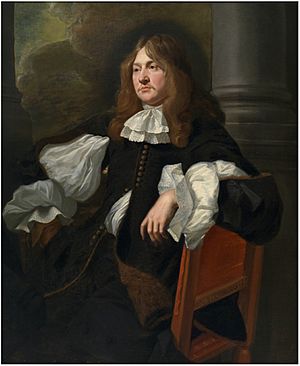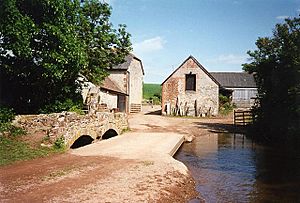Edmund Wyndham facts for kids
Quick facts for kids
Sir Edmund Wyndham
|
|
|---|---|

St Decuman's, Wyndham Chapel
|
|
| Knight Marshal | |
| In office 1667 – 1681 † |
|
| MP for Bridgwater | |
| In office April 1661 – January 1679 |
|
| Deputy Lieutenant of Somerset | |
| In office 1660 – 1681 † |
|
| Monarch | Charles II |
| MP for Minehead | |
| In office March 1628 – June 1629 |
|
| Personal details | |
| Born | circa 1600 Kentsford House, Somerset |
| Died | March 2, 1681 (aged 80) Whitehall, London |
| Resting place | St Decuman's Church, Watchet |
| Nationality | English |
| Spouses | Christabella Pyne (d.1658) Elizabeth Savage |
| Relations | Sir Francis Wyndham |
| Children | Three sons, one daughter |
| Parents | Sir Thomas Wyndham, Elizabeth Coningsby (died 1635) |
| Alma mater | Wadham College, Oxford |
| Military service | |
| Allegiance | |
| Rank | Colonel |
| Commands | Governor of Bridgwater 1643-1645 |
| Battles/wars | First English Civil War Taunton Bridgwater |
Sir Edmund Wyndham (born around 1601 – died 2 March 1681) was a powerful landowner from Somerset, England. He served as a Member of Parliament (MP) at different times between 1625 and 1679. An MP is a person elected to represent a group of people in the national parliament.
At first, he disagreed with King Charles I's government. However, things changed in 1630. His wife became the wet-nurse (someone who breastfeeds a baby) for the King's son, the Prince of Wales.
After this, Sir Edmund received special payments from the government. In 1641, he was removed from Parliament. This was because he had a "monopoly," which meant he had the only right to sell or make certain things.
When the First English Civil War began in 1642, he became a strong leader for the King's side, known as the Royalists. He was put in charge of gathering soldiers in Somerset.
He served as the governor of Bridgwater from 1643. This town was important for the Royalists. In July 1645, Bridgwater was captured by the Parliamentarian forces. Sir Edmund was held prisoner until 1649.
He then escaped to join Charles II in exile. He only returned to England after King Charles II was restored to the throne in 1660.
Even though he was elected to Parliament again in 1661, he felt he wasn't paid enough for his loyalty. He died in March 1681.
Contents
Who Was Sir Edmund Wyndham?
Edmund Wyndham was born around the year 1600. He was the oldest son of Sir Thomas Wyndham and Elizabeth Coningsby. His family, the Kentsford Wyndhams, was a branch of a very large and powerful family in Somerset.
He had five brothers. Three of them died during the wars that took place between 1638 and 1651. One of his brothers was Sir Francis Wyndham.
In 1623, Edmund married Christabella Pyne. She became the nurse for the Prince of Wales in 1631. They had four children who lived to adulthood: Hugh, Thomas, Carolina, and Charles. After Christabella died in 1658, Edmund married Elizabeth Savage in 1667. They did not have any children together.
Sir Edmund's Career and the Civil War
Early Political Life
Edmund went to Wadham College, Oxford for his education. In 1620, he began studying law at Lincoln's Inn. This was a common part of a gentleman's education back then.
He became a Member of Parliament for Minehead in 1625 and 1628. During these times, he supported Parliament's disagreements with King Charles I.
However, his views changed in 1630. This was when his wife became the nurse for the King's baby son. After this, Edmund received several government jobs and payments.
From 1629 to 1640, King Charles I ruled without Parliament. He needed new ways to make money. One way was by selling "monopolies." This meant giving one person or company the only right to make or sell something. Edmund was given a monopoly as a "soap searcher." This was unpopular because these searchers could enter private homes.
Edmund also invested a lot of money in draining wetlands, called "fenland reclamation." This project caused many problems and cost a lot of money. It was not finished until the 1650s.
The English Civil War (1642-1646)

In April 1640, Edmund became an MP for Bridgwater. He was elected again in November 1640. But in January 1641, he was removed from Parliament because of his monopolies.
When the First English Civil War began in August 1642, King Charles I made Edmund a "Commissioner of Array" for Somerset. This meant he helped gather soldiers for the King's army. He became a Colonel in the Royalist army. He raised two regiments of soldiers from Somerset. One of these was led by his son, Sir Hugh.
In 1643, he became the governor of Bridgwater. He also helped surround the Parliamentarian stronghold of Taunton in September 1644. When attempts to capture Taunton failed, he tried to starve the defenders. But in December, Parliamentarian forces helped Taunton, and Edmund went back to Bridgwater.
On 14 June 1645, the Parliamentarian army, called the New Model Army, won a big battle at Naseby. The New Model Army then joined other Parliamentarian forces. They forced the Royalist army to retreat from Taunton. The next day, the Royalist army was defeated at Langport.
Even though Bridgwater was well-defended, it surrendered on 23 July 1645. Edmund was captured and put in prison until 1649. He then escaped to Jersey and joined Charles II. He did not take part in the next part of the Civil War. However, his brother Francis helped King Charles escape after the Battle of Worcester in 1651.
After the War (1647-1681)

Edmund's standing with King Charles II weakened after his wife Christabella died in 1653. Soon after, he had a disagreement with the Earl of Clarendon. Edmund and others accused Clarendon of being a traitor.
This made King Charles very angry. Because of this, Edmund was not given important political jobs after the King returned to power in 1660. He did represent Bridgwater in Parliament from 1661 to 1679. He was also made a Deputy Lieutenant of Somerset. But many people wanted rewards from the King, and Charles could not satisfy everyone.
Edmund claimed he had spent over £60,000 helping the King. However, he only received a job as Knight Marshal in 1667. He said this job only paid him £1,200 a year.
When his son Sir Hugh died in 1671, his tombstone mentioned his father's disappointment. It said Edmund felt he had not been properly paid for his service to the King. Edmund died in London at the age of 80. He was buried in his family's tomb at St Decuman's Church, Watchet. His grandson, also named Edmund, became his heir. In 1690, his second wife, Elizabeth Savage, said she was almost starving because her allowance was not being paid.
Images for kids






